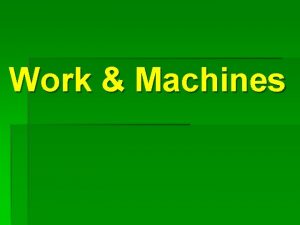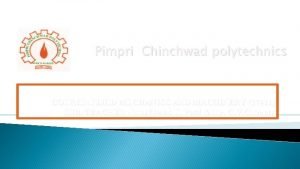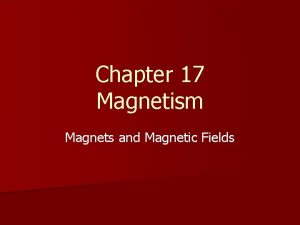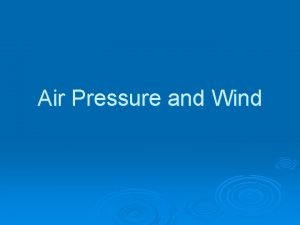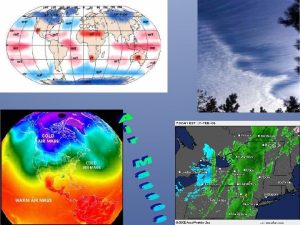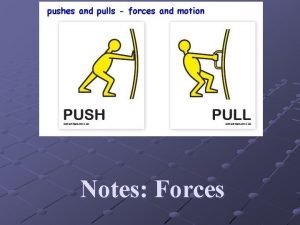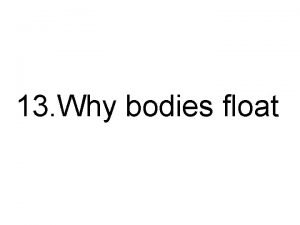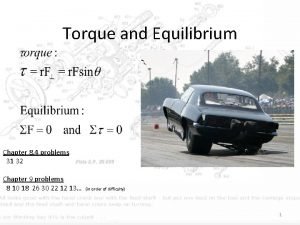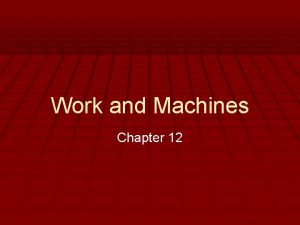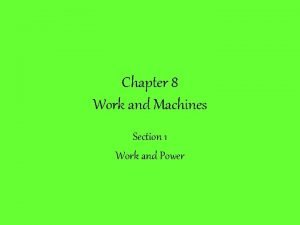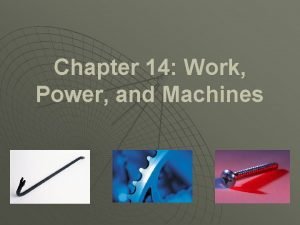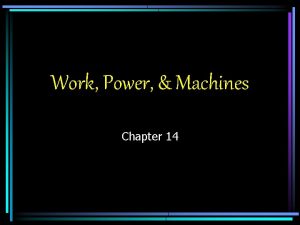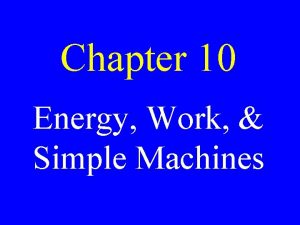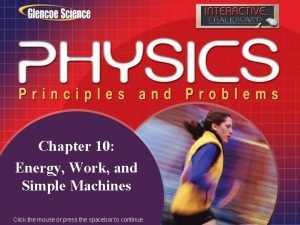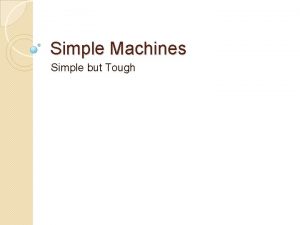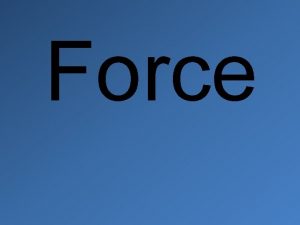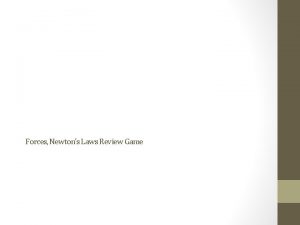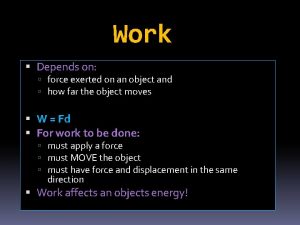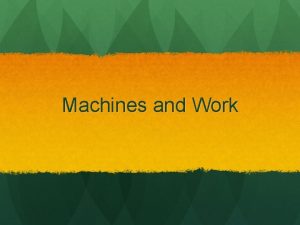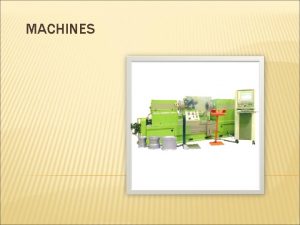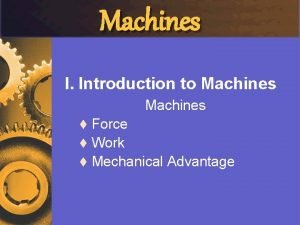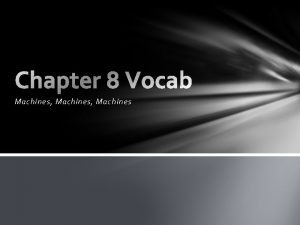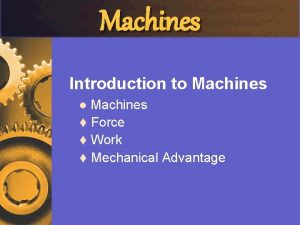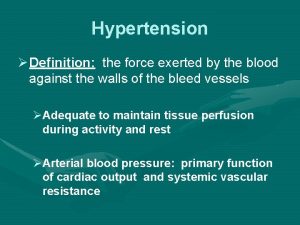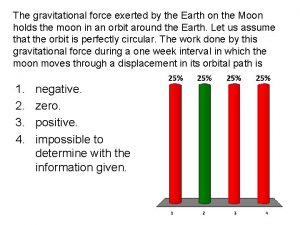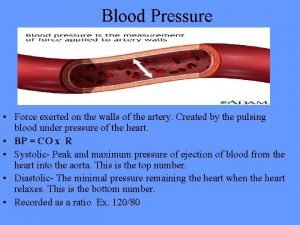Work Machines Review Work Work is force exerted


















- Slides: 18

Work & Machines

Review Work § Work is force exerted on an object that causes the object to move some distance § Force without moving a distance yields NO WORK!! When work is done, a transfer of energy always occurs.

1) Power and work § Power is related to work. § The amount of work done in a certain amount of time. § Power = work/time §P=W/t § Units for power is - Watt(W) § It is a Joule/second (J/s)

2) Power and Energy § Power is also related to energy. § When energy is transferred from one object to another. § Power = energy/time § P = E/t

Machine § A device that makes work easier or more effective § by changing the amount of force, the distance covered or the direction of the force

§ Mechanical Advantage (MA) -number of times a machine multiplies the effort force. § Ideal Mechanical Advantage (IMA)- theoretical performance of a machine if no energy was lost to friction. § IMA = resistance force / effort force § IMA = FR/FE § It’s a ratio- the units cancel.

Efficiency of a Machine § Since work is lost to friction, the amount of work obtained from a machine is always less than the amount of work put into it. § Efficiency = work output/ work input x 100 Remember that work = force x distance


Inclined Plane § A sloping surface that can reduce the amount of force to do work. IMA = length of incline / height of incline

Wedge § A one or two sided inclined plane that changes the direction of the force

Screw § an inclined plane wrapped around a cylinder

Lever § A rigid bar that pivots over a fulcrum (a fixed point). IMA = length of effort arm length of resistance arm Draw 3 classes of levers and give examples of each.

1 st Class Levers § Notice how § The input & output forces are in opposite directions § The fulcrum is between the input & output forces § Examples include nail remover, paint can opener scissors, seesaw

2 nd Class Levers § Notice how: § The input & output forces are in the same direction § Input force is farther away from the fulcrum than the output force § Examples include: wheel barrow, door, nutcracker

3 rd Class Lever § Notice how: § The input & output forces are in the same direction § The input force is closer to the fulcrum than the output force § Examples include rake, shovel, baseball bat and fishing pole

What Class of Lever? 3 2 1 4 5 6 7 st Class 4. 2 nd Class 1. _______ 3 rd Class 2. _______ 1 st Class 3. 1 _______ nd Class 6. rd Class 7. 1 st Class 8. nd Class 5. 2 _______ 6. 3_______ 8. 2_______ 8

Wheel and Axle § two circular objects attached together about a common axis § Wheel is the large cylinder § Axle is the small cylinder IMA = Radius of the wheel Radius of the axle

Pulley § A cord wrapped around a wheel. § IMA = the number of ropes that support the weight
 The force exerted on an object by a machine
The force exerted on an object by a machine Force exerted by jet on moving plate formula
Force exerted by jet on moving plate formula Force exerted by magnetic field
Force exerted by magnetic field Solenoid bbc bitesize
Solenoid bbc bitesize Global pressure
Global pressure Section 4 review physical science
Section 4 review physical science How to calculate applied force
How to calculate applied force In which direction is air pressure exerted?
In which direction is air pressure exerted? Balanced force facts
Balanced force facts Calculate pressure exerted by a screw on the wooden plank
Calculate pressure exerted by a screw on the wooden plank What is the maximum torque exerted by a 55 kg person
What is the maximum torque exerted by a 55 kg person Section 1 work and machines answer key
Section 1 work and machines answer key Section 1 work and machines
Section 1 work and machines Chapter 14 work power and machines
Chapter 14 work power and machines Differentiate between simple machine and compound machine
Differentiate between simple machine and compound machine Chapter 14 work power and machines
Chapter 14 work power and machines How do machines make work easier
How do machines make work easier Chapter 10 energy, work and simple machines answer key
Chapter 10 energy, work and simple machines answer key Energy work and simple machines chapter 10 answers
Energy work and simple machines chapter 10 answers
